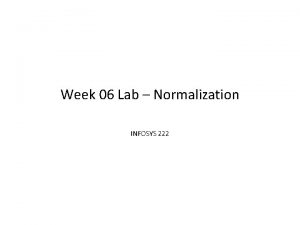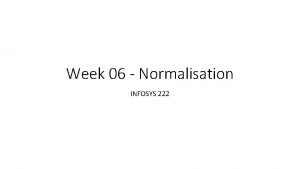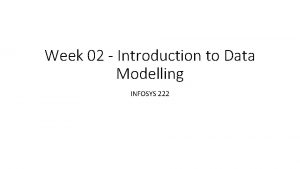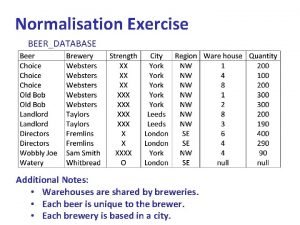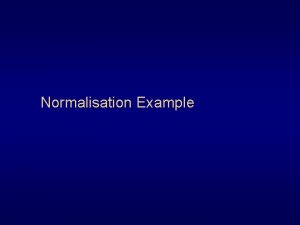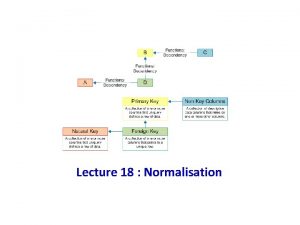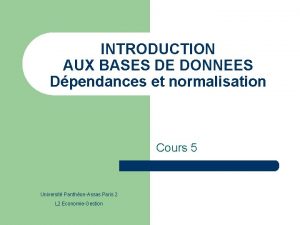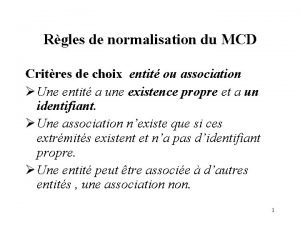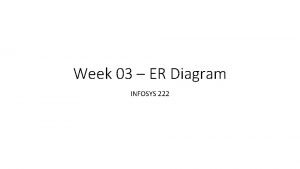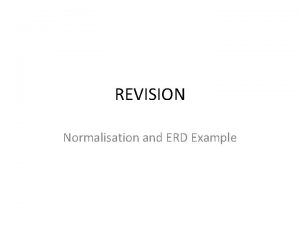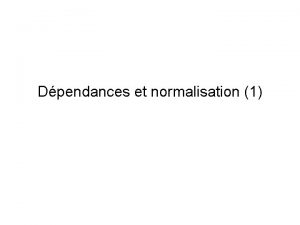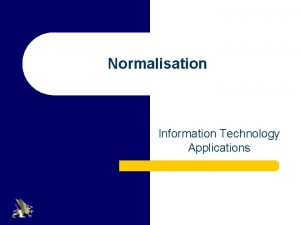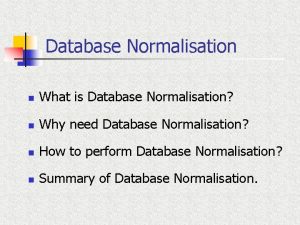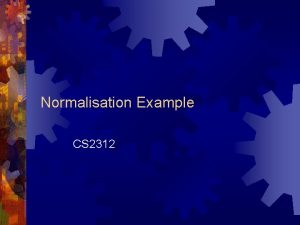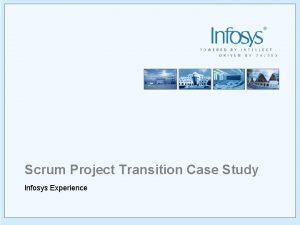Week 06 Normalisation INFOSYS 222 Agenda Normalisation and













- Slides: 13

Week 06 - Normalisation INFOSYS 222

Agenda • Normalisation and normal forms • 1 NF, 2 NF and 3 NF • Practice on normalisation with previous exam questions

Normalisation • What is normalisation? • Why do we need normalisation? • What would we achieve at the end of normalisation? • What are 1 NF, 2 NF and 3 NF? • What are functional dependencies? • What are partial functional dependencies? • What are transitive functional dependencies

Normalisation • Normalisation is a process that “improves” a database design by generating relations that are of higher normal forms. • The objective of normalisation: • “to create relations where every dependency is on the key, the whole key, and nothing but the key”.

Work Allocation Chart emp_N rank_I rank_De salary No ame d sc project_ No project_Desc project_Start _Date 123 John 01 Sr. Engr 52 K ABC 34 Waste disposal 01/03/15 456 Alan 03 App. Spec 35 K QXN 88 Sludge treatment 20/06/15 555 Peter 02 Engr 40 K ABC 34 Waste disposal 12/03/15 467 Jane 03 App. Spec 35 K BAT 20 N 2 O Generation 09/05/15 555 Peter 02 Engr 40 K QXN 88 Sludge treatment 15/06/15 123 John 01 Sr. Engr 52 K BAT 20 N 2 O Generation 03/05/15

Functional dependencies • We say an attribute, B, has a functional dependency on another attribute, A, if for any two records, which have • the same value for A, then the values for B in these two records must be the same. We illustrate this as: • A B Example: We only track one name for each employee. Suppose each employee is identified by their unique employee number. We say there is a functional dependency of name on employee number: employee number employee name

Functional dependencies If emp_No is the PK then the FDs: emp_No emp_Name emp_No rank_Desc emp_No salary must exist. • emp_No is not the PK : A row is not unique • emp_No and project_No : is unique

Partial dependency A partial dependency exists when an attribute B is functionally dependent on an attribute A, and A is a component of a multipart candidate key. emp_No project_Start. Date project_Desc Candidate keys: {emp_No, project_No} project_Desc is partially dependent on {emp_No, project_No} as project_No is a determinant of project_Desc and project_No is part of a candidate key

Transitive dependency Consider attributes A, B, and C, and where A B and B C. Functional dependencies are transitive, which means that we also have the functional dependency A C We say that C is transitively dependent on A through B.

Transitive dependency emp_No rank_Id emp_No emp_Name rank_Id rank_Desc rank_Id rank_Desc emp_No emp_Name rank_Id rank_Desc is transitively dependent on emp_No via rank_Id emp_No rank_Desc

INFOSYS 222 AC 2007 Exam 101 • Derive a set of relation in 3 NF. Show each step of normalisation clearly. All PKs should have a solid underline and FKs a dashed line. Draw an ERD for the derived relations

INFOSYS 222 AC 2016 Exam

INFOSYS 222 AC 2016 Exam • Derive a set of relations in third normal form (3 NF), using the data shown in figure above Clearly show each step of normalisation – 1 NF, 2 NF and 3 NF
 Infosys 222
Infosys 222 Infosys 222
Infosys 222 Introduction of infosys
Introduction of infosys Log222
Log222 Opendns family shield
Opendns family shield Week by week plans for documenting children's development
Week by week plans for documenting children's development Agenda sistemica y agenda institucional
Agenda sistemica y agenda institucional Risk normalization
Risk normalization Normalisation
Normalisation Normalisation
Normalisation Determinancy diagram
Determinancy diagram Normalisation des données définition
Normalisation des données définition Mcd location de voiture
Mcd location de voiture Organisation internationale de normalisation
Organisation internationale de normalisation
